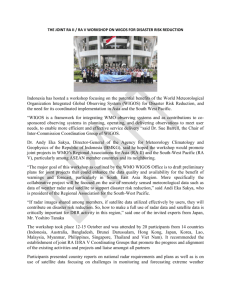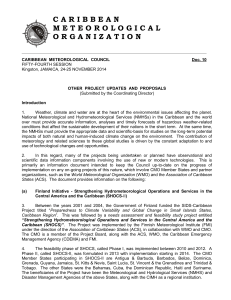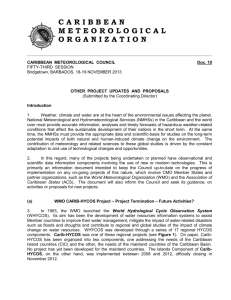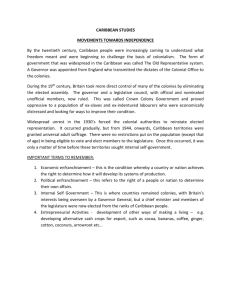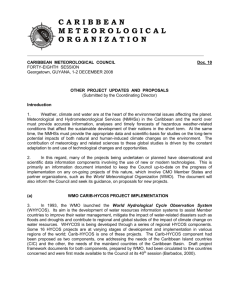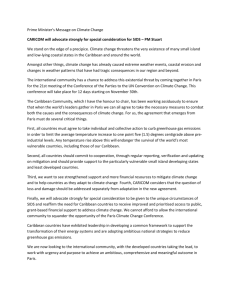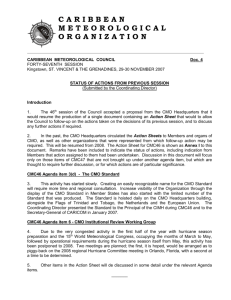CMC55, Doc 12 - Caribbean Meteorological Organization
advertisement
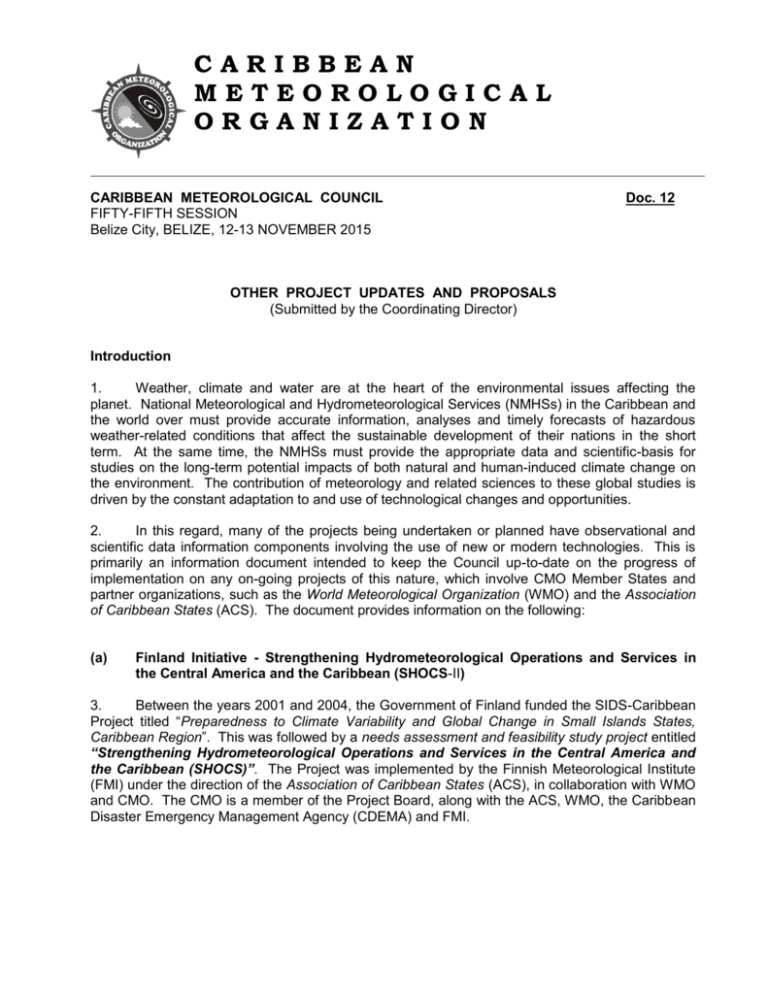
CARIBBEAN METEOROLOGICAL ORGANIZATION CARIBBEAN METEOROLOGICAL COUNCIL FIFTY-FIFTH SESSION Belize City, BELIZE, 12-13 NOVEMBER 2015 Doc. 12 OTHER PROJECT UPDATES AND PROPOSALS (Submitted by the Coordinating Director) Introduction 1. Weather, climate and water are at the heart of the environmental issues affecting the planet. National Meteorological and Hydrometeorological Services (NMHSs) in the Caribbean and the world over must provide accurate information, analyses and timely forecasts of hazardous weather-related conditions that affect the sustainable development of their nations in the short term. At the same time, the NMHSs must provide the appropriate data and scientific-basis for studies on the long-term potential impacts of both natural and human-induced climate change on the environment. The contribution of meteorology and related sciences to these global studies is driven by the constant adaptation to and use of technological changes and opportunities. 2. In this regard, many of the projects being undertaken or planned have observational and scientific data information components involving the use of new or modern technologies. This is primarily an information document intended to keep the Council up-to-date on the progress of implementation on any on-going projects of this nature, which involve CMO Member States and partner organizations, such as the World Meteorological Organization (WMO) and the Association of Caribbean States (ACS). The document provides information on the following: (a) Finland Initiative - Strengthening Hydrometeorological Operations and Services in the Central America and the Caribbean (SHOCS-II) 3. Between the years 2001 and 2004, the Government of Finland funded the SIDS-Caribbean Project titled “Preparedness to Climate Variability and Global Change in Small Islands States, Caribbean Region”. This was followed by a needs assessment and feasibility study project entitled “Strengthening Hydrometeorological Operations and Services in the Central America and the Caribbean (SHOCS)”. The Project was implemented by the Finnish Meteorological Institute (FMI) under the direction of the Association of Caribbean States (ACS), in collaboration with WMO and CMO. The CMO is a member of the Project Board, along with the ACS, WMO, the Caribbean Disaster Emergency Management Agency (CDEMA) and FMI. CMC55, Doc 12, page 2 4. The feasibility phase of SHOCS, called Phase I, was implemented between 2010 and 2012. A Phase II, called SHOCS-II, was formulated in 2013 as a two and a half-year project, with a budget of one Million Euros. The CMO Member States that currently participate in SHOCS-II are Antigua & Barbuda, Belize, Dominica, Grenada, Guyana, Jamaica, St. Kitts & Nevis, Saint Lucia and St. Vincent & the Grenadines. The other participating States are Cuba, the Dominican Republic, Haiti and Suriname. Regrettably, Barbados and Trinidad & Tobago, which participated in the early phases of SHOCS-I, were no longer eligible for assistance in SHOCS-II due to their development ranking by the Organisation for Economic Co-operation and Development (OECD), which is used by the Government of Finland. The beneficiaries of the Project have been the National Meteorological and Hydrological Services (NMHS) and Disaster Management Agencies of the above States, along with the CIMH as a regional institution. 5. SHOCS-II officially comes to a close at the end of 2015. The Key outcomes of this project can be summarized as follows: Increased Capacity in the Caribbean on the development of methods for Multi-hazard Early Warning Systems and Disaster Risk Reduction: o The network of SmartMet weather forecast workstation and production system was established, by installing the system in 8 new countries in the region; o SmartAlert tool for issuing and disseminating weather warnings was piloted in 3 countries. Increased capacity in developing Quality Management Systems (QMS): o Two inter-linked training workshops on QMS for Aeronautical Meteorological Services were organized in May and December 2013 with participation from altogether 19 Caribbean SIDS Meteorological Services/Offices. Increased capacity in communicating the weather to large audience and TV weather presentation: o Introduction to a modern TV weather presentation technology was accomplished by the installation of TV weather presentation software in INSMET Cuba; o A TV weather presentation workshop was held in Havana in June 2015 for some 40 participants from 16 countries. Increased amount and quality of the observation data: o Spares for non-working and old weather observation sensors were provided to 11 countries. 6. A final meeting of the SHOCS-II Steering Committee, combined with a workshop with representatives of participating countries will take place in Barbados on November 18, 2015. It will focus on drawing conclusions from the results of the SHOCS-II phase of the Project and to discuss the identified priorities for capacity building during a continuing SHOCS-III phase, which is expected to begin in 2016. CMC55, Doc 12, page 3 7. In this regard, there will be approximately 160,000 Euros available for a Phase III. Council will recall that attempts were being made to undertake some radar training under the SHOCS-II Project. Logistical considerations made this difficult to achieve in 2015. However, discussions are already underway to carry this activity into SHOCS-III. Part of the consideration could be to combine radar training funded by SHOCS with other radar training. As an example, Belize has informed the CMO Headquarters of a NOAA-funded training event for radar-technicians, with training experts from the German radar supplier. Belize has offered to open the training to technicians from the other radar sites in the CMO Radar Network. Therefore CMO and the SHOCS-II project team have begun examining the practicality of making this possible under SHOCS-III. (b) Other CMO Project Proposals/Involvement (i) Regional component of the WMO Integrated Global Observing System (WIGOS) 8. Under Agenda Item 5, Council was provided with the latest plans for implementation of the Region's component of the WMO Integrated Global Observing System (WIGOS). WIGOS is an allencompassing approach to the improvement and evolution of WMO’s global observing systems. The implementation of WIGOS is very closely related to the WMO Information System (WIS), both of which are essential to all technical and scientific activities of Meteorological Services in the Caribbean and worldwide. The CMO Headquarters plays a major regional and international role in the implementation of WIGOS and WIS. Mr Glendell DeSouza of the Caribbean Meteorological Organization Headquarters is the Task Team leader. In this regard, activities in 2016 will be increased as WIGOS will be entering its Pre-operational Phase (2016–2019). (ii) Severe Weather Demonstration Project 9. Under Agenda Item 5, Council was also informed of WMO plans within the region to introduce a Severe Weather Forecasting Demonstration Project (SWFDP) for the region. The CMO Headquarters is already involved in the development of the conceptual phase of SWFDP. It is anticipated that, as described under Agenda Item 11, the ongoing collaboration between CMO and the Meteorological Service of France (Météo-France) under the Carib Risk Cluster Project, will involving the use of the Météo-France’s “SHERPA” Intranet facility in the development by WMO of an SWFDP for the Eastern Caribbean, in the first instance. It is anticipated that the Management Group of the WMO Regional Association IV (North America, Central America and the Caribbean) will approve the development of the SWFDP in early 2016. ACTION PROPOSED TO COUNCIL 10. The Council is invited to: Note the updated information and provide any guidance necessary on (i) The Finland-funded Project for the Strengthening Hydrometeorological Operations and Services in the Central America and the Caribbean (SHOCS II), and (ii) Other projects involving the CMO Headquarters. ___________ CMO Headquarters October 2015
